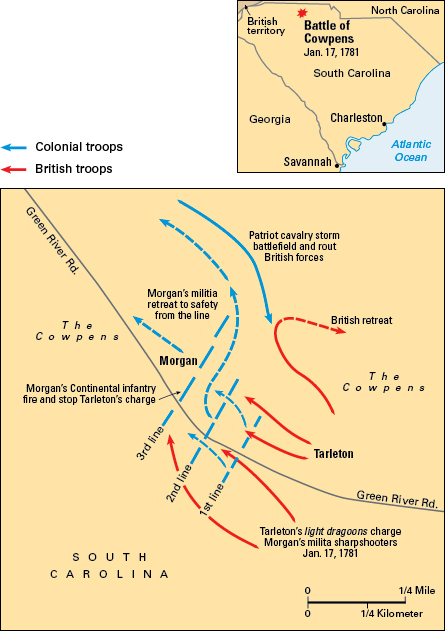
Cowpens, Battle of, was one of the most complete victories won by the Americans during the American Revolution (1775-1783). The battle took place in northern South Carolina in January 1781. Patriot troops under the command of Brigadier General Daniel Morgan destroyed a British army led by Lieutenant Colonel Banastre Tarleton.
Background.
In May 1780, the British captured the port of Charleston, South Carolina. About 5,000 American soldiers surrendered. American Major General Horatio Gates then formed a new Southern army to replace the one lost at Charleston. In August, Gates suffered a defeat near a British base at Camden, South Carolina. The Battle of Camden marked a low point for the patriots. But the battle caused the British to become overconfident. A British force led by Lieutenant General Lord Charles Cornwallis prepared to invade North Carolina. In October, an American force surrounded and captured the left wing of Cornwallis’s army on Kings Mountain, just inside South Carolina.
Also in October 1780, Major General Nathanael Greene replaced Gates as commander of the Southern army. Greene divided his troops into two detachments. He led one, and he put Morgan in charge of the other.
Greene sent Morgan’s force to western South Carolina to disrupt British supply lines and provide encouragement for patriot militias. Cornwallis sent Tarleton, a young commander, in pursuit of Morgan. Morgan’s troops prepared for battle in a cattle-grazing area known as the Cowpens in northern South Carolina.
The battle.
On the morning of Jan. 17, 1781, Morgan organized his troops into three lines at Cowpens. About 150 yards (137 meters) separated each of the lines. The first line consisted of militia sharpshooters. Morgan told them to fire two volleys and then retreat to the second line. The second line was made up of more militia. Their orders were to fire upon the enemy before retreating to Morgan’s third line. The third line was made up of disciplined Continental infantry and yet more militia.
Tarleton’s light dragoons (soldiers on horseback) charged the patriot lines. Tarleton expected the patriot forces to panic and flee. But Morgan’s sharpshooting rifles held off the initial attack. The patriot troops then fell back, according to Morgan’s plan. Morgan’s experienced third line stopped Tarleton’s charge. Patriot cavalry then stormed the battlefield, leading to a rout of Tarleton’s forces. During the course of the battle, about 70 Americans were killed or wounded. British losses numbered about 330. Another 600 British soldiers were captured.
Two months after Cowpens, Greene met Cornwallis’s weakened force at Guilford Courthouse in North Carolina. The British forced the Americans from the battlefield but suffered hundreds of casualties.
